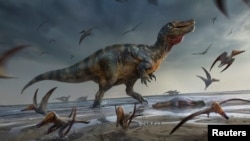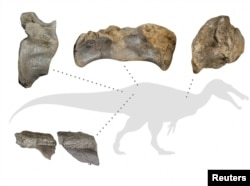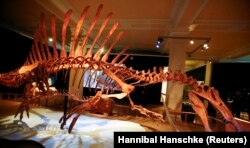Scientists say they have discovered remains on Britain's Isle of Wight that might belong to a meat-eating dinosaur larger than any other known from Europe.
The creature was closely related to the biggest carnivorous dinosaur species on record.
Researchers said recently they have found parts of the fossilized bones of the dinosaur. It lived about 125 million years ago during a time known as the Cretaceous Period. The findings include bones of the back, hips and tail, but not the skull or teeth. Based on the partial remains, they estimated that the dinosaur was more than 10 meters in length and possibly much longer.
Chris Barker was the lead writer of the study that was published in PeerJ Life & Environment.
Barker described the creature’s size as "impressive.” He added,” It is one of the biggest - and possibly the biggest - known land predator[s] ever” to walk Europe.
Based in part on small marks on the top of the tail, scientists believe that it belonged to a group of dinosaurs called spinosaurs. This group included Spinosaurus, which lived about 95 million years ago. At about 15 meters long, it is considered the longest-known dinosaur predator.
Spinosaurs had long heads much like crocodiles with lots of teeth, strong arms, and big claws. They ate water creatures as well as other dinosaurs.
Because the remains are incomplete, the researchers have not yet given the newly described dinosaur a scientific name. For now, they are calling it the "White Rock spinosaurid" based on the layer of rocks where the bones were found. They believe it is not a member of any identified species.
Meat-eating dinosaurs belonged to a group called theropods. Large examples once lived on all major land masses or continents. They walked on two legs and the largest had huge skulls and strong teeth.
Spinosaurus was Africa's largest. Tyrannosaurus rex, approaching 13 meters, was North America's king, while the similarly-sized Giganotosaurus ruled in South America and the slightly smaller Tarbosaurus in Asia. The largest-known, identified theropod from Europe was Torvosaurus, at about 10 meters.
The newly described dinosaur might turn out to be as long as T. rex, said Neil Gostling, who was responsible for the study’s publication process.
"This one is really big," Gostling said. "Let's hope more fossils turn up. We would love a skull or teeth."
Looking at the teeth could help researchers better understand this dinosaur's position on the development of spinosaurs.
The fossilized bones were found on the surface along Compton Bay on the southwestern coast of the Isle of Wight. At the time, sea levels were much higher than today and large parts of Europe were under water.
The Isle of Wight has become one of Europe's richest places for dinosaur remains. The same team of researchers last year announced the discovery of two other Isle of Wight spinosaurs, both measuring about nine meters in length.
Those finds combined with the latest one support the idea that spinosaurs began and developed in Western Europe before spreading to other places.
I’m Jill Robbins.
Will Dunham reported on this story for Reuters. John Russell adapted it for VOA Learning English.
___________________________________________________________________
Words in This Story
fossilized –adj. changed from living tissue to minerals and rock
species – n. biology : a group of animals or plants that are similar and can produce young animals or plants : a group of related animals or plants that is smaller than a genus
predator – n. an animal that lives by killing and eating other animals : an animal that preys on other animals
claw – n. a sharp curved part on the toe of an animal (such as a cat or bird)
fossil – n. something (such as a leaf, skeleton, or footprint) that is from a plant or animal which lived in ancient times and that you can see in some rocks











